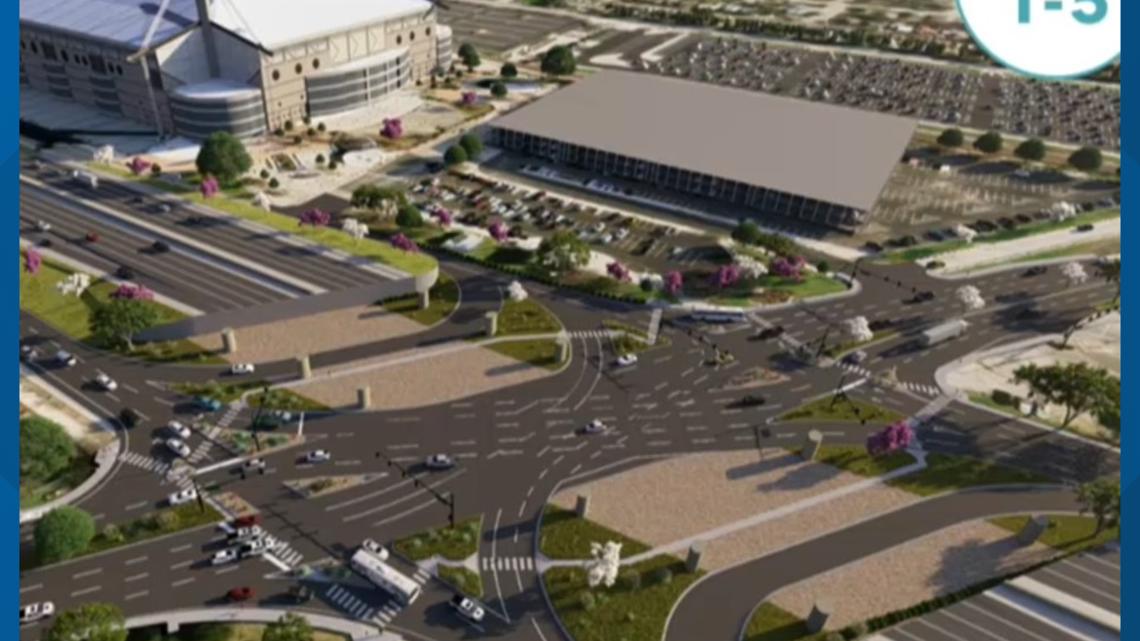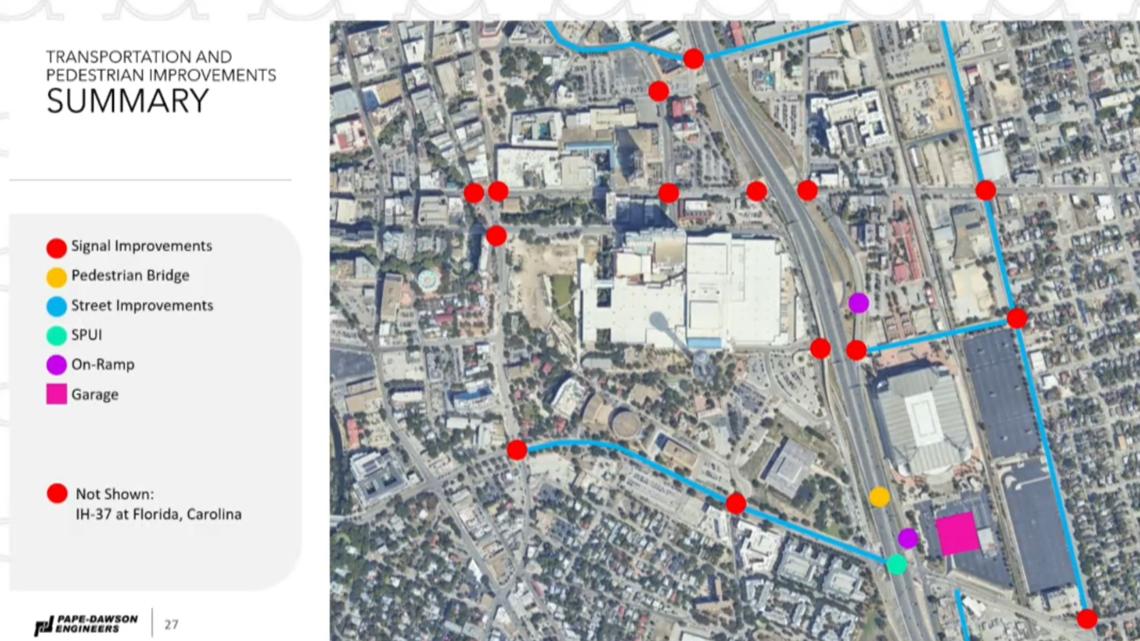At a City Council briefing, a local firm talked through all the new ways drivers and pedestrians could navigate downtown in the coming years.
SAN ANTONIO — A pedestrian bridge over Interstate 37, a parking garage outside the Alamodome, the introduction of ride share options and Park & Ride stations—it’s all on the table for San Antonio over the next five years as the city and its partners work to answer one of the biggest questions around Project Marvel.
That question: Is downtown infrastructure prepared for the inevitable influx of visitors that would want to explore the city’s dream of a sports and entertainment district, anchored by a new Spurs arena in the heart of the city?
When major events like Fiesta, Alamodome concerts, New Year’s Eve celebrations or the recently concluded Final Four return to downtown San Antonio, they also tend to bring streams of red lights and pedestrian-clogged sidewalks. At a City Council briefing on Wednesday, San Antonio-based engineering firm Pape-Dawson unveiled a laundry list of potential changes that officials hope can prepare downtown to take the next step.
The brunt of that potential development in concentrated around the Alamodome area, where Pape-Dawson Senior Vice President Tom Carter said the firm has come up with ways to ease transportation headaches while keeping the area safe and traversable for those on foot.
“Pape-Dawson is uniquely qualified to work on this project,” Carter said, adding the firm has spent the last year examining how to improve downtown. “This team has worked on most of the major projects in San Antonio over the last 20 years.”
Walking between venues
Among the new infrastructure that could be built downtown is a pedestrian bridge that stretches over I-37 and connects the plaza levels of the Alamodome and a new Spurs arena. The city and NBA team are in continuing talks over how to fund that billion-dollar project, and are eying the Texas Pavilion site, which until last year housed the Institute of Texan Cultures.
The pedestrian bridge is a different project than the land bridge previously touted by the City of San Antonio as a core Project Marvel element; construction on that likely wouldn’t get underway until the 2030s.
A new parking garage
Carter said Pape-Dawson is also considering building a 2,500-space parking garage in the middle of what is now Lot A of the Alamodome.
That would bring much-needed vehicle real estate to a part of town where visitors often head into Southtown neighborhoods and residential areas to hunt for street parking as they make their way to major events. A garage just outside the Alamodome doors would presumably be a primary parking area for Spurs fans arriving to games just across the highway.
Say hello to ‘SPUI’
That’s “Single Point Urban Interchange,” a modernized intersection design that allows for smoother flow of traffic by using alternative traffic light stages, according to a TxDOT fact sheet. That cuts traffic delays at stop lights and makes it easier for larger vehicles to make wide turns.
There are only a handful of SPUI interchanges in Texas, including one at Harry Wurzbach and Austin Highway in San Antonio. This new one would be installed at Cesar Chavez Boulevard and I-37, where Carter says the new-and-improved intersection would increase the hourly capacity of cars traveling through the area by 60%.


He added the plan has TxDOT’s early seal of approval.
A new highway on-ramp
Pape-Dawson is also proposing an additional on-ramp to I-37 between Montana and Commerce streets, in order to avoid a “bottleneck” of cars and motorists at Commerce, especially for people leaving Alamodome events.
That’s part of a wider plan to install new turn lanes and improve traffic signal timing in different locations around downtown to decrease the time cars spent sitting in congestion.
More opportunity for parkin’ and ridin’
Carter said the firm is also reviewing ways to maximize the east side’s Robert Thompson Transit Station as a Park & Ride station for downtown events while also using VIA’s rapid transit Green and Silver lines for additional stops or pickup points. In theory, that would have a trickle-down effect: Less people heading downtown in their own cars, less congestion and headaches for those trying to find a parking spot.


What’s next?
It remains to be seen how much all this could cost, but city officials said Wednesday that some of the dollars would come through a combination of TxDOT funding and a potential infrastructure bond election that could provide between $220 million and $250 million.
“We know that we have needs for infrastructure. We know we need better parking, better transit in downtown San Antonio,” said Mayor Ron Nirenberg, who is nearing the end of his time in office. “All of that needs to happen. I’m confident that voters and future elected officials will see the wisdom in moving forward in all of this.”
That second funding source would have to be approved by voters. It’s the hope of city leaders, including City Manager Erik Walsh, that it gets voted on this November; in order for that to happen, City Council must approve calling the election before Aug. 18.
“Our municipal bond programs have historically been done with no projected increase in the tax rate,” Walsh said. “That is still, from the staff’s perspective, part of our analysis and assumptions going into it.”
